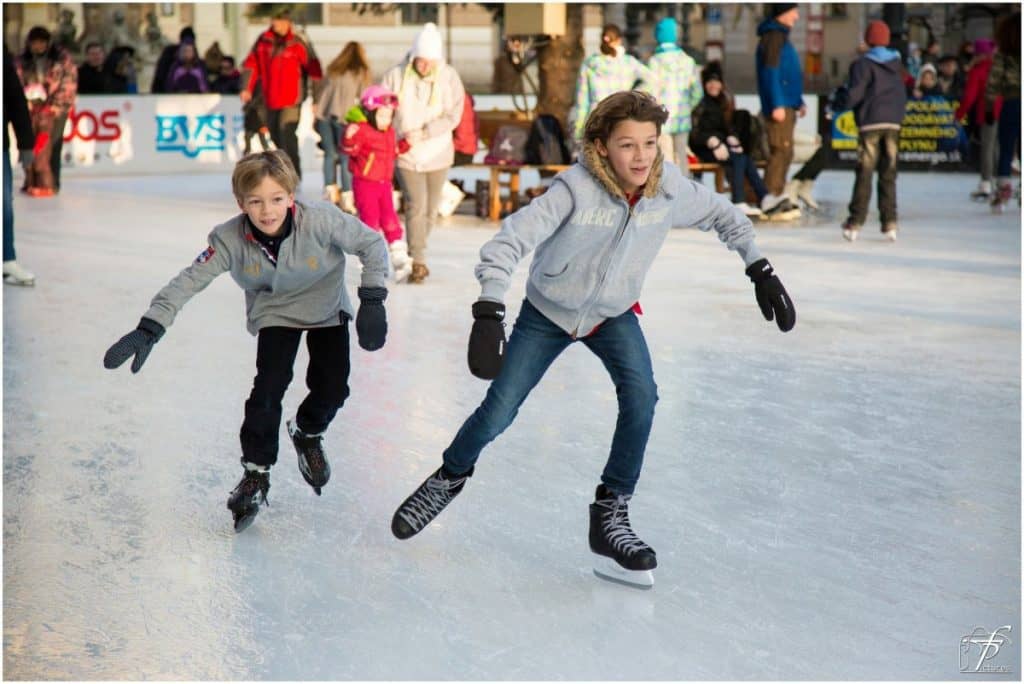
Summer is right around the corner and that means it’s time for you to head inside and cool off. Why not hit up your local ice rink to see what they have to offer?
Ice skating is very affordable. The average cost of public skating costs around $10-$15 dollars with rentals for a few hours. For freestyle ice skating on average will be around $7 per 30 minutes session without rental. With skate rental for an hour will cost you just under $20. Children under the age of 5 can usually skate for $5 for a few hours.
A 30 minutes private one-on-one session for figure skating with an instructor will cost you around $20-$50 depending on the instructor.
In the meantime, I suggest to you stick with the public skating for now until you are comfortable on the ice and can move with more confidence. Let’s put on some skates!
How to Tie your Ice Skates
This might not occur to many that go ice skating, but you don’t simply slip on the ice skates like you would with a normal pair of shoes. There are some key steps to remember:

First all of, after you get rent your skates at the counter and don’t worry they’ll will determine what shoe size you need based on what size shoes you normally wear.
Where was I? Oh yeah, after you get your skates, you’ll often find these plastic wood benches outside the skating rink. Go ahead and slip one foot in your skates and slide the blades into the grooves of the bench. This will help stabilize the skates while you tie them.
I would love to go into great details as to how to tie a pair of skates, but it would be too confusing in writing so I found this short video that explains it really well:
If you have any trouble with tying your skates, ask a staff for help, they get this question all the time and would often be more than happy to help.
Once you have your skates on nice and snug, it’s time to head to the rink, and yes, you’re ankle and your feet will hurt a bit from the tightness of the skates, that’s normal.
Slippery Ice: How to Not Fall on Your Bum
Ice skating is a sport and and art form and with every sport, injuries are far too frequent, especially when it comes to ice skating. Falling numerous times is the price of entry.
Start off by holding onto the wall around the rink for as long as you can until you get use to the low chills and the feeling of the blade on ice.
Stay close to the wall and move one foot at a time, you will not be able to do any of those figure skating moves like you see in the Winter Olympics just yet.
Move one foot forward to glide straight then shift the weight onto your other foot. As your foot move passed your weighted foot, you’ll want to brush outward with an angle like shown below.
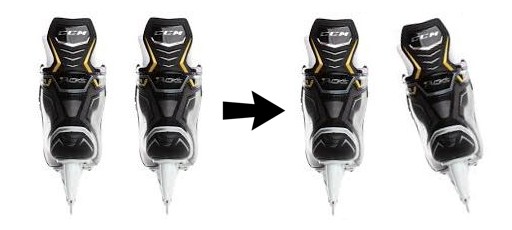
Once you glide forward the desired distance, shift the weight to your other foot and glide with the previously weighted foot like this:

Like I’ve said, stick to the wall for as long as you need to, taking an hour or two to get used to it is normal. It took me a lot longer, but eventually I was able to leave the wall.
When you start to get the hang of it, start skating a little bit further away from the wall. While you skate forward, trying leaning forward at a bend, it will help counterbalance the force when you’re pushing your feet backwards, this will help maintain your center of gravity.
The best thing you can do to reduce the chance of falling is to not try some crazy tricks or take sharp turns if you don’t know how to stop. Gaining too much speed is also dangerous, not only for you, but for the people skating around you, so please be respectful and skate cautiously.
How does Ice Skating compare to Roller Skating?
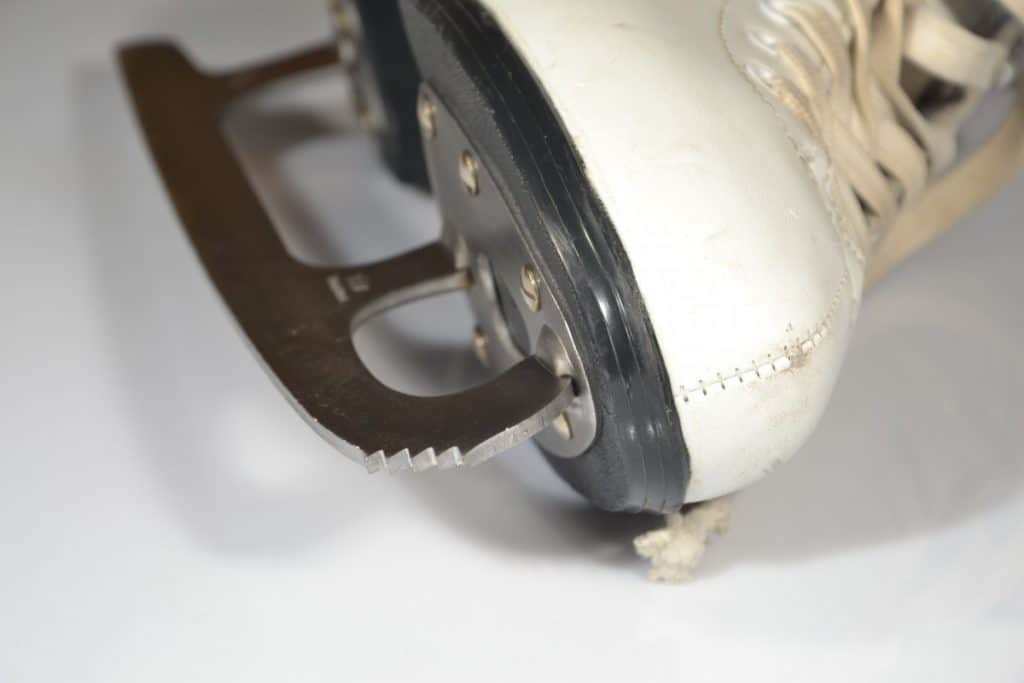
Ice skating is very similar to roller skating with one key difference. Rollers skates have 4 wheels that are spread out to evenly distribute the weight of each foot, but with ice skating, you’re literally balancing yourself on a blade that’s no thicker than 3/8″.
So in comparison, ice skating is like roller skating if you are gliding, but it is more like rollerblading when you are pushing yourself forward in a fanning motion.
If you want to get the hang of ice skating without freezing your butt off, you can try practicing rollerblading on ground to get the hang of the motion. Once you’re comfortable, it will translate quite well to ice skating via muscle memory.
Got Kids? No Problem!
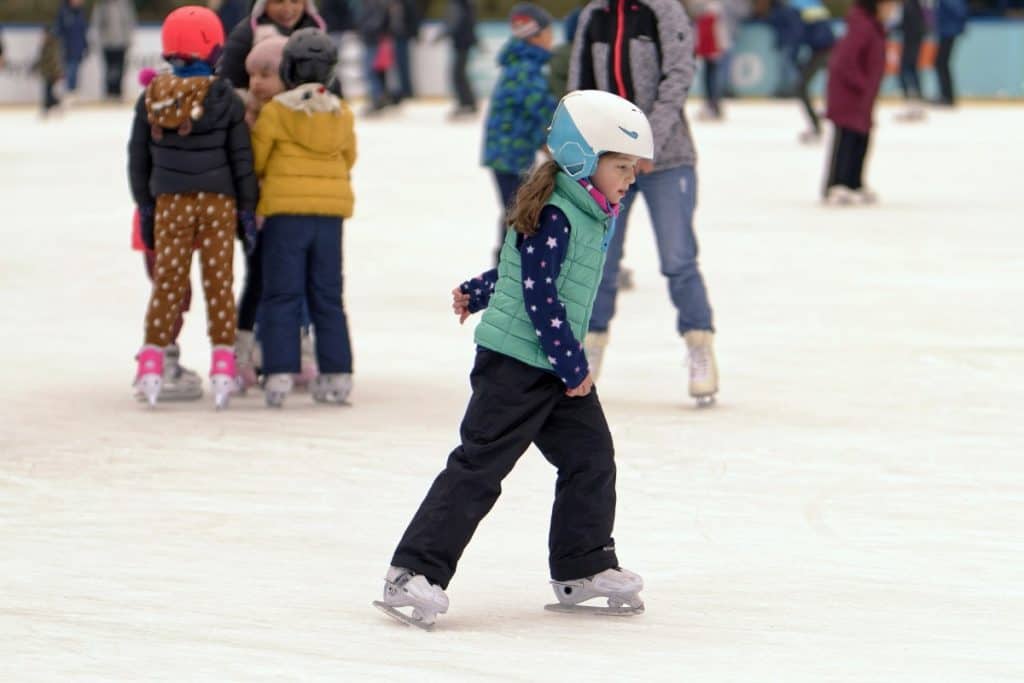
You’d be amazed at how fast kids can pick up ice skating and since they are small they won’t fall as hard as you do.
If you have kids that would like to learn how to ice skate, start them off with a skate trainer, it’s like the training wheels on a bike, except you use push it like a shopping cart.

You can rent one like this and to be honest they usually just offer it for free. The one you’ll get may look a little bit different than this, the ones I’ve seen are made of plastic without the adjustable height grips. Oh! And get a helmet, while you’re at it.
If you’re short like kids, unfortunately, they usually won’t let you use it, so be prepare to just fall and learn like everyone else.
Indoor / Outdoor Ice Skating Attire

If you’re going to go ice skating be prepared to layer on some clothes, a typical ice rink will keep the temperature around 24°F or -4.4°C. Outdoor ice skating may be a little bit warmer, but you’ll have to account for wind chills and that might not be something pleasant to deal with.
You’ll need a thick jacket, I recommend you wear a puffer jacket for it’ll keep you warm and it has a waterproof exterior. Wear a sweater underneath for optimal warmth.
Wear some long and thick socks and a pair of soft gloves. It will keep your fingers from getting frostbites and prevent your hands from chapping too much.
A beanie, a pair of earmuffs, and a scarf are optional, but I would highly recommend it to make your time in the ice rink as comfortable as possible.
Usually people go ice skating in jeans, but a nice thick pair of joggers are also suitable, but just know that the pants might absorb some of the moisture in the air and you’ll freeze a little.
The Risks of Ice Skating
Ice skating can be a dangerous hobby especially without proper training and techniques.
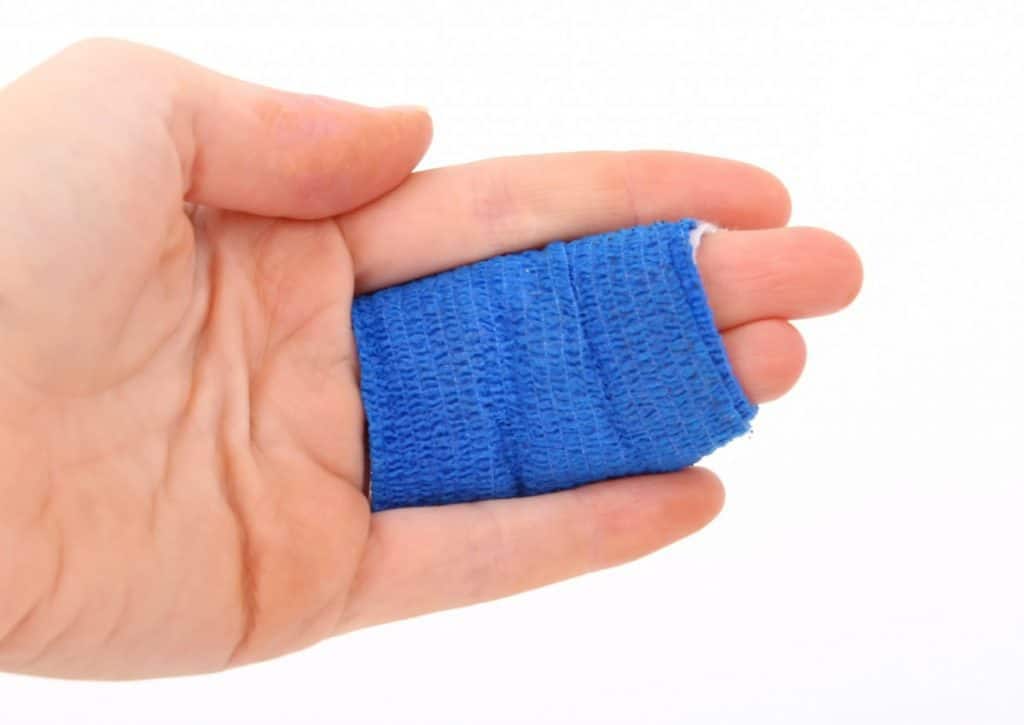
The type of risks that you’re taking includes:
- Chapped Skin
- Runny Nose
- Muscle Soreness
- Twisted Ankles
- Butt hurting from falls
- Breaking Hands or Arms
- Bloody Nose
- Losing Teeth
- Concussion
All of these sounds scary, but do not be afraid, because you can pretty much injury yourself like what’s mentioned above in any sports or activities. Heck, I twisted my ankle walking up the stairs the other day. The chances of the bottom 4 injuries are very low if you play it safe.
To minimize the chances of injuries, try wearing a jacket that’s long enough to extend to the butt, it will give you extra padding if you land on it.
Keep your personal belongings either in your car, lockers, or zipped up in your jacket pockets. You don’t want to skate with keys or phone in your pants pockets as that can jab you in a fall.
If you like wearing watches, consider bringing a sports watch to go ice skating instead, so you don’t crack the glass and hurt your wrist from a metal watch band.
Ice skating is really a graceful art form that is easy to start, hard to master, but dazzles all those who look upon it. Professionals make these jumps and spins look effortlessly, but it took a lot of hard work, concentration, dedication and let’s not forget injuries.
By learning ice skating, not only is this a fun activity you can do with your friends, but it opens the doors for you to learn figuring skating, playing hockey, and more. So, venture forth and become the next snow princess or ice king!
